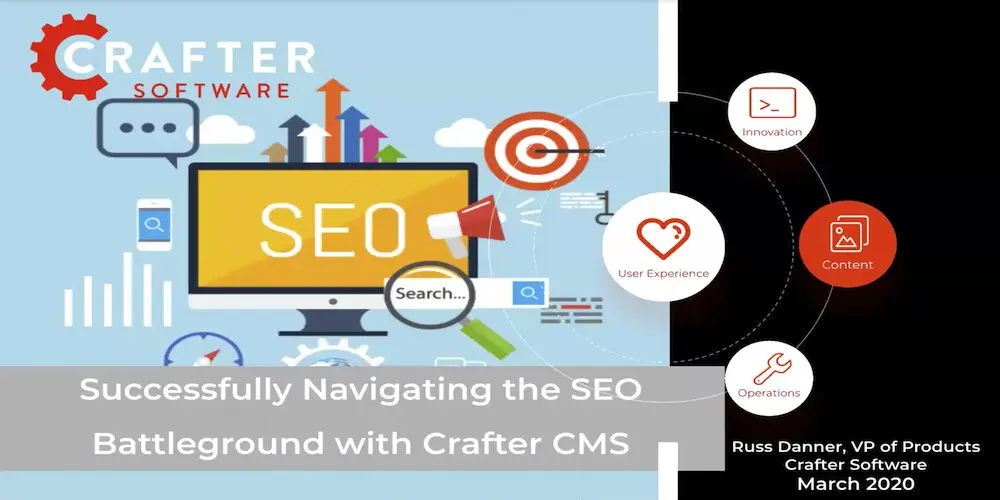AI-First Content Management: Transforming Enterprise Content Workflows

Amanda Jones

AI is a powerful force transforming how content is created, managed, and delivered across digital experiences. For content-centric businesses, this means far more than automating routine tasks; it’s about fundamentally rethinking content operations and unlocking new possibilities with AI.
Yet many organizations make the mistake of simply layering AI onto existing content workflows, capturing incremental productivity gains but missing out on transformative impact. Becoming AI-first means redesigning your entire content lifecycle—from creation to delivery—so your teams can innovate faster and smarter.
At CrafterCMS, we help organizations navigate this evolving landscape with AI-powered content management solutions that accelerate time to market, improve relevance, and enable personalized digital experiences. Below are key insights and principles for embracing AI-first content management.
Key Takeaways for AI-First Content Management
-
AI empowers content teams by redesigning workflows, not just automating repetitive tasks
-
Intelligent content management frees creators to focus on innovation and storytelling
-
Robust data and metadata management unlocks AI-driven insights and personalization
-
Governance and security are essential for trusted AI-powered content operations
Five Core Principles for Becoming AI-First in Content Management
1. AI as a Capability Multiplier
AI doesn’t just speed up existing content tasks, it expands what’s possible. Imagine generating rich, multi-channel content variations with a single prompt or automating complex content assembly tailored to each user. Leading companies embed AI agents deeply into their content workflows, enabling smarter decision-making and creative problem-solving at scale.
2. Human-AI Collaboration
AI handles mundane, repetitive content tasks—like tagging, summarizing, or basic copy generation—freeing content professionals to focus on creativity, strategy, and audience engagement. Successful teams foster an AI-savvy culture where authors and developers experiment with AI tools confidently, fueling continuous innovation.
3. AI-Native Content Platform Design
Traditional CMS interfaces aren’t built to support the dynamic, autonomous AI agents now powering content operations behind the scenes. AI-native platforms emphasize adaptability, real-time collaboration between humans and AI, and seamless integration of intelligent services that optimize content delivery and personalization continuously.
4. Trustworthy AI Anchored in Data Privacy and Governance
Content often contains sensitive data, so privacy and security remain paramount. AI-driven content systems must enforce strict permissions and governance to ensure only authorized users and agents access protected information. Transparency in AI decision-making and bias mitigation is critical to maintaining trust across content workflows.
5. Data as the Strategic Asset for AI
Content management organizations sit on a vast trove of unstructured data that include documents, media files, contracts, and more. AI’s breakthrough ability to structure and extract insights from this data transforms it into a strategic asset. With strong content governance and metadata practices, AI can power faster content searches, smarter recommendations, and more effective automation.
How to Identify High-Impact AI Use Cases in Content Management
Start with foundational AI deployments that bring quick wins such as AI-assisted content tagging, automated transcription, or summarization. These improve efficiency, help teams build confidence, and lay the groundwork for broader AI adoption.
Once foundational AI capabilities are embedded into your content systems, the next step is to focus on high-value opportunities where AI can meaningfully transform how content is created, curated, and delivered. For example:
-
AI-augmented content generation and editing workflows: Generative AI tools, especially when enhanced with enterprise-specific content, can accelerate writing, rewriting, summarization, and translation tasks while maintaining brand voice and editorial standards. They can also assist with versioning content for different audiences, formats, or channels, and can assist with metadata creation and tagging.
-
AI-driven content strategy and planning: Tools can identify trending topics, audience intent shifts, and content gaps by analyzing search patterns, competitor content, and performance metrics -- enabling smarter editorial calendars and campaign planning.
-
Content ideation and creative assistance: AI can help brainstorm article titles, product descriptions, social media hooks, and video storyboards, providing creative support that aligns with SEO and user engagement goals.
-
Search Engine Optimization (SEO) and Generative Engine Optimization (GEO): AI tools optimize content structure, keywords, schema markup, and summaries for traditional search engines and emerging generative AI engines, improving discoverability in both types of experiences.
-
Web accessibility and compliance automation: AI can detect and suggest fixes for accessibility issues (e.g., alt text, contrast, ARIA tags), helping ensure digital content meets WCAG and regional compliance standards without slowing down production workflows.
- Automated contract and compliance document intelligence: AI models can extract, classify, and validate critical terms, clauses, and obligations within legal, regulatory, or internal documents. All to help reduce risk, ensure consistency, and improve turnaround time.
These high-leverage applications of AI help organizations scale content operations, ensure compliance, and deliver more relevant, accessible, and effective digital experiences. Each industry and organization will find different transformational use cases. The key is to identify where AI can best amplify content value, improve user experiences, or drive new revenue streams.
Understanding AI Maturity in Content-Driven Enterprises
Content organizations typically progress through stages of AI maturity:
-
Stage 1: AI supports content search and basic insight generation; humans lead workflows
-
Stage 2: AI automates predefined content tasks, like tagging or metadata extraction
-
Stage 3: AI agents collaborate across systems to solve complex content challenges
-
Stage 4: AI improves its own content workflows autonomously, with human oversight
-
Stage 5: AI independently manages large-scale content functions, enabling humans to focus on strategy and innovation
Knowing your organization’s AI maturity helps prioritize investments and set realistic goals for your content management transformation.
Leading with an AI-First Mindset in Content Management
Adopting AI in content management goes beyond new tools—it's a cultural and operational shift. It requires:
-
Embracing experimentation and continuous learning with AI technologies
-
Building secure, scalable infrastructure that supports AI-human collaboration
-
Establishing strong governance to ensure trust, privacy, and compliance
-
Rethinking workflows to harness AI’s full potential to augment creativity and productivity
As AI agents begin running 24/7 behind your content systems, expect faster content cycles, more relevant experiences, and entirely new business opportunities.
Ready to take the leap? Embracing an AI-first approach to content management empowers your teams to create smarter, faster, and more impactful digital experiences.
The future belongs to organizations that don’t just automate—but fundamentally rethink—how content drives business value.
Contact us today to get started on your AI content management journey.
Related Posts

From Content Author to AI Co-Creator: The Next Evolution of CMS Workflows with MCP

Amanda Lee

What is the Model Context Protocol (MCP)? A CMS Developer’s Guide to AI Integration

Amanda Lee

Java Technologies for AI Applications: Why Enterprises Still Bet on Java

Amanda Jones

Content Management is Dead? Wrong! It’s the Future of AI-Powered Digital Experiences

Mike Vertal







